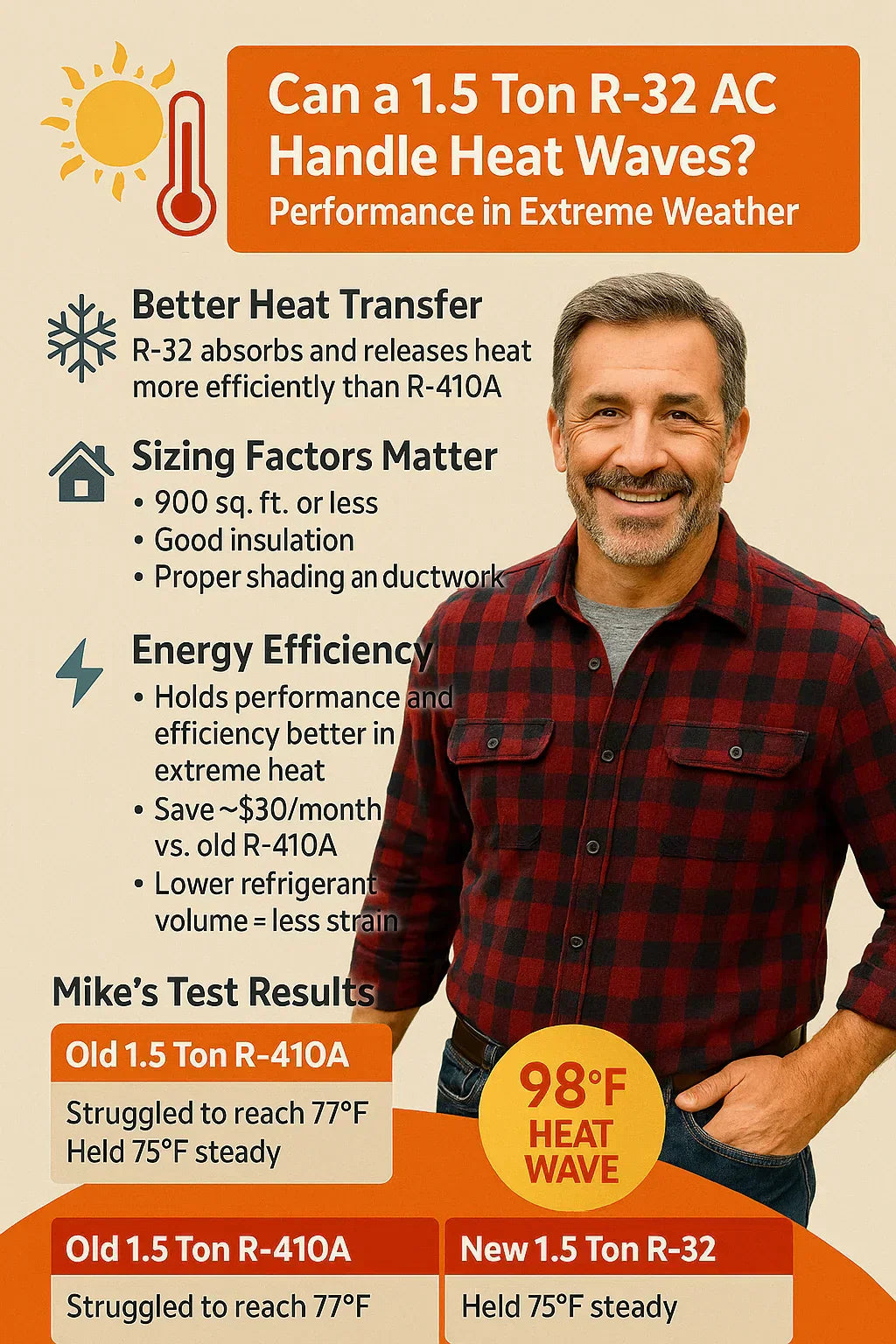🔎 Introduction: Mike’s Heat Wave Story
Last July, Mike Sanders’s town endured one of the hottest summers on record. His old R‑410A system ran all day and still couldn’t cool his living room below 78 °F. Frustrated, he upgraded to a 1.5‑ton R‑32 system.
But a question still nagged him:
“Can a 1.5‑ton R‑32 AC really handle these extreme heat waves, or will I be sweating again next summer?”
This guide breaks down how R‑32 systems perform when the heat is brutal, what factors matter most, and how homeowners like Mike can maximize comfort without skyrocketing energy bills.
🧊 1. R‑32 vs. R‑410A: Why It Matters in Hot Weather
Not all refrigerants perform equally under stress.
⚙️ Better Heat Transfer
-
R‑32 absorbs and releases heat more efficiently than R‑410A, thanks to higher thermal conductivity and lower viscosity.
-
This means your system can move more heat with less refrigerant—20–30% less charge volume is needed (Daikin).
🌍 Lower Strain in Heat Waves
-
R‑410A systems struggle at very high outdoor temperatures because the refrigerant pressure spikes.
-
R‑32 operates at slightly lower pressure and maintains stable performance, reducing compressor stress.
📈 Real-World Efficiency Gains
Most R‑32 units show 5–10% better cooling efficiency compared to similar R‑410A models (Energy.gov).
Mike’s takeaway: His new R‑32 system doesn’t just run cooler—it runs smarter under stress.
🏠 2. Does a 1.5 Ton System Fit Your Home in a Heat Wave?
Even the best refrigerant can’t fix a mismatch between system size and home needs.
📐 Square Footage Guide
-
1.5 tons = ~18,000 BTUs/hour.
-
Ideal for homes sized 600–900 sq. ft. with good insulation (EnergyStar.gov).
🧱 Insulation & Home Envelope
-
Well-insulated homes perform up to 30% better during heat waves.
-
Drafty homes force even high-efficiency systems into marathon cycles.
🪟 Windows & Sun Exposure
-
South- and west-facing windows without shades can add thousands of BTUs of heat gain.
-
Mike installed thermal curtains in his living room—and saw indoor temps stabilize quickly.
🌬️ Ductwork Condition
-
Leaky ducts waste 20–30% of cooled air
-
During a heat wave, that’s the difference between cool comfort and sweating at 5 pm.
⚡ 3. Energy Efficiency in Extreme Weather
R‑32 units not only keep running in the heat—they often maintain higher efficiency.
📊 SEER2 Ratings Matter
-
SEER2 15–17+ is typical for new R‑32 units.
-
Older R‑410A units average SEER2 13–14, meaning 10–15% higher energy use.
🔋 Continuous Comfort with Inverter Tech
Most modern R‑32 systems include inverter compressors:
-
Adjust speed based on need
-
Avoid the wasteful on/off cycle
-
Maintain steady indoor temps instead of wild swings
💡 Mike’s Numbers
-
Old R‑410A: $142 July bill, struggled to hit 77 °F.
-
New R‑32: $107 July bill, held 75 °F steady.
-
Savings: $35 in one hot month—over $300 annually in a hot climate.
🔧 4. Design Features That Give R‑32 Systems the Edge
When the sun beats down, it’s not just the refrigerant that matters—it’s the design.
🌀 Inverter Compressors
-
Avoid overheating by modulating output.
-
Extend system lifespan by reducing hard starts.
📦 Enhanced Coil Design
-
Larger and more efficient coils extract heat even at 95–105 °F.
🌡️ Variable Fan Speeds
-
Keep airflow consistent.
-
Prevent short cycling and maintain comfort in multiple rooms.
🔒 Built-in Protections
-
High-pressure switches to prevent damage.
-
Overheat sensors to shut down safely if needed.
-
Leak safeguards, since R‑32 is mildly flammable (ASHRAE).
🌍 5. Safety & Reliability in Heat Waves
🔥 R‑32’s Mild Flammability (A2L Rated)
-
Safe in professionally installed systems.
-
Only flammable in high-concentration enclosed leaks—rare in well-sealed homes.
🔧 Professional Installation Required
-
Certified techs follow new EPA and ASHRAE guidelines for R‑32.
-
Ensures your system is leak-free and code-compliant.
💡 6. Mike’s Pro Tips for Surviving Heat Waves
✅ Thermostat Settings
-
Set to 78 °F when home, 82 °F when away
-
Use “Auto” fan mode instead of “On” to avoid $20–50/month extra costs
✅ Ceiling Fans
-
Create a wind-chill effect, letting you raise your thermostat by 4 °F without losing comfort (The Spruce).
✅ Filter Changes
-
Every 30–45 days during summer.
-
A clogged filter reduces efficiency by 10–15%.
✅ Close Curtains & Seal Drafts
-
Mike saw a 3 °F indoor temp drop just by using thermal curtains on his west-facing windows.
✅ Pre-Summer Tune-Ups
-
A $100 tune-up can save hundreds in peak-season failures (HomeAdvisor).
📊 7. Mike’s Heat Wave Test: Real Results
Conditions:
-
Outdoor temps: 98 °F for 3 consecutive days.
-
Home size: 850 sq. ft., insulated attic, west-facing living room.
Old R‑410A 1.5 Ton:
-
Couldn’t cool below 77 °F.
-
Compressor ran 18 hours/day.
-
$142 monthly bill.
New R‑32 1.5 Ton:
-
Held steady at 75 °F.
-
Compressor ran 14 hours/day.
-
$107 monthly bill.
Mike’s verdict:
“My R‑32 didn’t just survive the heat wave—it made me feel like I finally beat the summer.”
✅ Conclusion: Is a 1.5 Ton R‑32 AC Heat Wave Ready?
For Mike and homeowners like him, the answer is yes—if the system is:
-
Properly sized for the home (≈600–900 sq. ft.)
-
Paired with good insulation and shading
-
Maintained with filter changes and seasonal tune-ups
R‑32 refrigerant, inverter technology, and smart thermostat use make modern 1.5‑ton systems capable of holding comfort even in 100 °F+ heat waves—while keeping energy bills in check.
In the next topic we will know more about: DIY vs. Professional Install: What Mike Learned With His 1.5 Ton R-32 System







